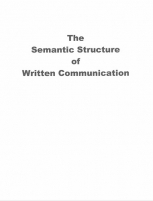 The Semantic Structure of Written Communication, 5th rev., by John Beekman, John Callow, and Michael Kopesec. (Summer Institute of Linguistics, 1981), 147 pages.
The Semantic Structure of Written Communication, 5th rev., by John Beekman, John Callow, and Michael Kopesec. (Summer Institute of Linguistics, 1981), 147 pages.
The “assumption underlying this work is that meaning is also structured, and that this structure is amenable to linguistic analysis and theory. Indeed, the purpose of this presentation is to set forth a theory of the structure of meaning—to give it a technical title, semantic structure” (14). The semantic structure that the authors lay out is hierarchical. The smallest unit of meaning is a concept, which is a linguistic feature that signifies one single idea. Multiple concepts make up propositions, which make up propositional clusters, which make up paragraphs, and so forth.
The authors argue that language has natural prominence built in. There is always a prominent idea within a piece of communication. This prominence may be natural (e.g., a purpose is more prominent than the means by which the purpose is achieved), or it may be marked by special linguistic features. An analysis of the semantic structure of a discourse entails finding the discourse constituents (concepts, paragraphs, etc.), finding the semantic relation between each of them, and discovering the most prominent semantic element through this analysis. The theory is therefore specially helpful for biblical exegesis.
The authors discuss other features of discourse analysis throughout, such as coherence and unity. Such features are discussed more in detail in the work of Brown and Yule. However, the authors throughout the work simply assert their theory rather than discussing other work in the field. This is probably because the work is meant to be a manual for Bible translators, which they desire to be simple and easily teachable. Thus, the discourse analysis student will want to be sure to supplement this work with others, especially works that deal with pragmatics and marked discourse features.
See other works on discourse analysis in our annotated bibliography.
